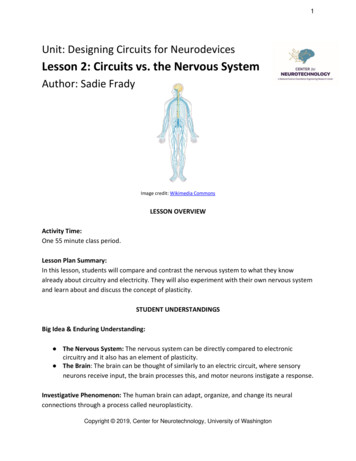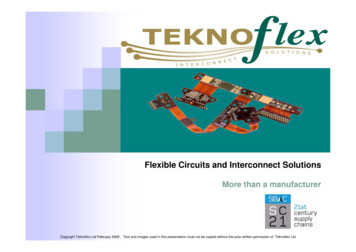
Transcription
1Unit: Designing Circuits for NeurodevicesLesson 2: Circuits vs. the Nervous SystemAuthor: Sadie FradyImage credit: Wikimedia CommonsLESSON OVERVIEWActivity Time:One 55 minute class period.Lesson Plan Summary:In this lesson, students will compare and contrast the nervous system to what they knowalready about circuitry and electricity. They will also experiment with their own nervous systemand learn about and discuss the concept of plasticity.STUDENT UNDERSTANDINGSBig Idea & Enduring Understanding: The Nervous System: The nervous system can be directly compared to electroniccircuitry and it also has an element of plasticity. The Brain: The brain can be thought of similarly to an electric circuit, where sensoryneurons receive input, the brain processes this, and motor neurons instigate a response.Investigative Phenomenon: The human brain can adapt, organize, and change its neuralconnections through a process called neuroplasticity.Copyright 2019, Center for Neurotechnology, University of Washington
2Driving Question: How does the nervous system compare to electronic circuitry?Learning Objectives:Students will know How the nervous system works on a macro scale. How the brain has plasticity. How the nervous system compares to electronic circuitry.Students will be able to Explain and demonstrate plasticity of the brain with simple experiments. Explain to another student the differences and similarities between an electronic circuitand the nervous system.Vocabulary: Auditory: Sensory information obtained through your auditory system (e.g.,outer/middle/inner ear, cochlear nucleus, auditory cortex in brain). Nervous System: Consists of the central nervous system (brain and spinal cord) andperipheral nervous system (all nerves throughout the body not part of the brain orspinal cord). Neuroplasticity: Also known as brain plasticity. The brain's ability to reorganize itself byforming new neural connections throughout life. This happens through learning andmemorization. Neuroplasticity occurs during brain development when the brainprocesses sensory information from infancy through adulthood. Neuroplasticity alsooccurs as an adaptive mechanism; for example, in the case of the brain injury, the brainmay compensate for lost functions or amplify remaining functions. Stimuli/Stimulus: Something that evokes a functional reaction, for instance visualstimulus that evoke a response in the brain. Some examples of stimuli include visual,tactile, auditory, smell, and motor. Tactile: Sensory information obtained through your sense of touch (e.g., pressure,temperature, texture). Visual: Sensory information obtained through your visual system (e.g., eyes, visualcortex in brain).Next Generation Science Standards:This lesson builds toward the following Performance Expectation (PE) and its integrated threedimensions of learning. Additional dimensions are denoted with an asterisk (*).High School Performance ExpectationsHS-LS1-2: Develop and use a model to illustrate the hierarchical organization of interactingsystems that provide specific functions within multicellular organisms. (Grades 9-12).Copyright 2019, Center for Neurotechnology, University of Washington
3HS-PS3-5: Develop and use a model of two objects interacting through electric or magneticfields to illustrate the forces between objects and the changes in energy of the objects due tothe interaction. (Grades 9-12).Science and EngineeringDisciplinary Core Idea(s)Crosscutting Concepts (CCCs)Practices (SEPs)Developing and Using Models LS1.A: Structure and Function Systems and System Models*Asking Questions andDefining ProblemsPS3.C: Relationship betweenEnergy and ForcesCause and EffectCopyright 2019, Center for Neurotechnology, University of Washington
4TEACHER es or meter sticks For nervous system reaction time activity. Each pair ofstudents will need two rulers taped together (0 end to 30end) or a meter stick.1/pair ofstudentsCalculatorsFor nervous system reaction time activity.1/pair ofstudentsStudent HandoutsStudent Handout 2.1: How Fast Can You React?1/studentStudent HandoutsStudent Handout 2.2: Venn Diagram1/studentor pairTeacher ResourceTeacher Resource 2.2: Venn Diagram Answer Key1Preparation1. Read and learn about neural plasticity if you do not already have an understanding orbackground. See the Resources section at the end of this lesson plan.2. Make copies of Student Handouts 2.1 and 2.2. Cut copies of Student Handout 2.2 in half.3. Gather all necessary supplies.4. Prepare supplies. If using rulers, tape two rulers together end-to-end, with the 0 end ofone ruler taped to the 30 end of the other ruler, making one very long ruler.PROCEDUREEngage: How Fast Can You React? Intro (5 min)1. Post the following entry task on the board or in whatever format you use in yourclassroom:a. Which cue would give you the fastest reaction time: visual (see), auditory (hear),or tactile (touch)? Why? Which would give you the slowest reaction time? Why?2. Ask students to complete the first step of Student Handout 2.1. They should be makingpredictions on how fast they think they can react to various cues. You may need toaddress how long an actual second is with them. Many students do not realize theactual length of a second or that they can answer with fractions of seconds.Copyright 2019, Center for Neurotechnology, University of Washington
53. Have students discuss the predictions they made with their table group.Explore: How Fast Can You React? Mini Lab (20 min)4. In pairs, have students complete the rest of Student Handout 2.1. They should becompletely filling out all of the data tables and answering all of the questions.Explain: Class Discussion (5-10 min)5. Engage the class in a discussion about what they did and observed. Make sure to specificallygo over their answers to the questions. Lead students into more of a discussion about thelast question and what this means for their nervous system.6. Tell students about plasticity and how it relates to the nervous system. Explain the differentcauses of neuroplasticity (see Teacher Background), and note that they are experiencing itright now, whenever they are engaged in learning and memorization.7. Optional: To help students understand how neuroplasticity works to change, organize, orstrengthen the neural connections in the brain, challenge students to a fun memory task.There are many options; here are a few:a. Concentration/Memory: Use a deck of cards that has pairs of picture cards. Place allcards face down. Take turns choosing two cards, trying to find the pairs.b. Sorting Cup Game: Get three matching plastic cups. Place a coin or other smallobject under one cup. Shuffle the cups by sliding and changing their position on thetable. Try to keep track of which cup has the object. Slowly increase the amount ofmoves you make with the cup, seeing how many moves can be easily remembered.c. Number Line: How big of a number can you remember? The first person says asingle-digit number. The second person says that number, followed by a new singledigit number, and so on. Continue until someone forgets a number.d. What’s Missing? Place an assortment of objects on a table or tray, covered with apiece of cloth. Life the cloth and allow a brief amount of time for everyone to look atthe objects and memorize them. Cover with the cloth. Discreetly remove one objectand rearrange them. Uncover the objects and ask, what’s missing? Start with 4objects, then increase in each round. As you get to larger numbers of objects, youcan have students write down a list to see how many objects they can remember.8. Ask students to decide whether or not their answer to Question #3 on Student Handout 2.1relates to this concept and what that means about their own nervous systems.a. If students look across their three trials, was there an improvement in reaction timeor not? Why may this be?b. One kinds of things might affect reaction time?c. In particular, you might discuss how the test subjects may develop strategies toimprove their reaction time (e.g., eliminating distractions, increasing focus) or thatthe brain is acquiring a new motor skill (catch the ruler!) by refining a sensory-motorCopyright 2019, Center for Neurotechnology, University of Washington
6pathway. In addition, the tester herself might also develop strategies to make theexperiment run more smoothly and consistently (e.g., knowing where to hold theruler when dropping it, making a consistent noise when dropping, etc.).Elaborate: Comparing and Contrasting (10-15 min)9. In pairs or table groups, have students fill out Student Handout 2.2. Remind them that theycan also reflect on what they learned about the nervous system with the jigsaw activity andvideos from Lesson One.10. Lead the class in a discussion on what they put on the handout in each category. Make surethat they have come up with examples in at least each category.11. Students will save this handout to draw from later on in Lesson 5.12. Post the following exit ticket on the board or in whatever format you use in your classroom:a. Write a one sentence summary of the Venn Diagram we just created.STUDENT ASSESSMENTAssessment Opportunities: Teachers can check on student understanding and engagement during the classdiscussions and while visiting the students as they conduct the experiment. The Student Handouts and entry/exit tickets can be used for assessment.Student Metacognition: Students will have time to work on the handouts collaboratively anddiscuss the lesson with their partners. Afterwards, they will keep both handouts in their journalor notebook to reference, particularly for Lesson 5.Scoring Guide: Students will be successful if they complete the lab and complete both of thehandouts.EXTENSION ACTIVITIESExtension Activities: More time could be spent on neuroplasticity and what it means. Studentscould potentially do some sort of mini research project associated with it. See the followingwebsites for more information or the possibility of extending the learning.Video: Neuroplasticity, Khan Academy (9:40 min)Close captioning and video transcript opyright 2019, Center for Neurotechnology, University of Washington
7Web Article: Brain Plasticity: What is it?, Neuroscience for KidsGrade 12 reading htmlAdaptations: This lesson can be adapted based on the student pairings for the activity. Youngerstudents could still do the lab activity, with more help/scaffolding during it.All videos linked in this lesson have closed captioning and transcripts available.TEACHER BACKGROUND & RESOURCESBackground Information: For this lesson and the one proceeding it, teachers need to have aworking understanding of the nervous system. It is also important to understand the scientificconcept of neuroplasticity. The resources listed elsewhere in this lesson are helpful for thatpurpose. In addition, this resource helps explain brain plasticity and neural pruning in moredepth.What is Brain Plasticity and Why is it so Important?The Conversation sticity-and-why-is-it-so-important-55967It is also important to understand the difference between the scientific concept ofneuroplasticity and the educational psychology concept of growth mindset. Neuroplasticity isthe brain's ability to reorganize itself by forming new neural connections. Neuroplasticity occursduring brain development when the brain processes sensory information from infancy throughadulthood. Neuroplasticity happens throughout the lifetime through learning andmemorization processes. Neuroplasticity also occurs as an adaptive mechanism; for example, inthe case of the brain injury, the brain may compensate for lost functions or amplify remainingfunctions. Growth mindset is a belief that intelligence is not fixed, but that can be developed. Itis inspired by the scientific concept of neuroplasticity, but growth mindset itself is a behavior orstrategy that impacts how people think about themselves, their brain, and their ability to learn.Resources:What is Brain Plasticity and Why is it so Important?The Conversation 4/4/16Reading level: College ticity-and-why-is-it-so-important-55967Video: Neuroplasticity, Khan Academy (9:40 min)Close captioning and video transcript availableCopyright 2019, Center for Neurotechnology, University of Washington
s-and-neurotransmitters/v/neuroplasticityWeb Article: Brain Plasticity: What is it?, Neuroscience for KidsReading level: Grade lCopyright 2019, Center for Neurotechnology, University of Washington
9Unit: Designing Circuits for NeurodevicesStudent Handout 2.1: How Fast Can You React?Name: Date: Period:INTRO: Make predictions for how fast (in seconds) it will take you to react and grab aruler based solely on the three cues provided on the data table: Visual (see), Auditory(hear), and Tactile (touch). Each cue will be the only one (for example, if it is auditory,you cannot see the ruler dropping). Make sure to record this in the Predicted ReactionTime column of Table 2: Data Summary on the next page.PROCEDURES:1. Assign one person to be the catcher and the other to be the dropper.2. The catcher stands with their dominant hand in front of them in a half open grip,like they are ready to catch a ruler with their pincher grip (thumb and forefinger).3. The dropper holds the taped rulers or meter stick, 0 side down, just above thecatcher’s hand so that if the ruler were to drop, it would go between their fingers.4. For the visual cue, the dropper simply drops the ruler and the catcher attemptsto catch it as quickly as possible. It is important that the dropper does thissilently. Once the ruler is caught, the catcher must not move their hand until thedistance dropped is recorded (in cm).5. Repeat Step #4 two more times.6. For the auditory cue, the setup is the same as Step #4, except that the catchernow closes their eyes. The dropper tells the catcher when they are dropping itinstead of being able to see it being dropped, by making a noise (“Go!” or“Drop!”). Again, record the distance dropped (in cm).7. Repeat Step #6 two more times.8. For the tactile cue, the setup is the same as Step #6, except that instead oftelling the grabber when they are dropping the ruler, the dropper gently taps thecatcher’s foot with their own foot, as they are simultaneously dropping the ruler.Again, record distance dropped (in cm).9. Repeat Step #8 two more times.10. Using the distance dropped data, calculate the actual reaction time for each trialusing the following equation where t is time, d is distance, and g is gravity (10m/s ): t d/g211. Average each cue’s reaction times by adding them up and dividing by three.Record the average reaction time for each cue.Copyright 2019, Center for Neurotechnology, University of Washington
10DATA:Table 1: Data CollectionCueTrial 1: Distance Dropped(cm)Trial 2: Distance Dropped(cm)Trial 3: Distance Dropped(cm)VisualAuditoryTouchTable 2: Data SummaryCuePredictedReaction Time(s)Trial 1: ActualReaction Time(s)Trial 2: ActualReaction Time(s)Trial 3: ActualReaction Time(s)AverageReactionTime (s)VisualAuditoryTactileQUESTIONS:1. Were your predictions accurate or not? Why or why not?2. What was most surprising about this lab? Why?3. Do you think that you could improve any of your reaction times? Why or why not?How?Copyright 2019, Center for Neurotechnology, University of Washington
114. What is the best/fastest cue for reaction time? Why?5. Do you think that where you are touched would affect your reaction time? Why?6. How does this activity affect your view on how different populations react todifferent stimuli?Copyright 2019, Center for Neurotechnology, University of Washington
12Unit: Designing Circuits for NeurodevicesTeacher Resource 2.2: Venn Diagram Answer KeySome possible student answers are listed below. Note this is not an exhaustive list.Circuits:On/offswitchMade up of electrial parts(battery, wires, resistors,etc.) Non biologicalEasier to fix when brokenRuns off of electricityNervous System:Never turns off NervecellsBiologicalUses chemicals totransmit informationDifficult to "fix" wheninjured or damagedRuns off of nutrientsBoth:Electrical/generates electricityTransmits signalsReceives signalsCommunicationMust be connectedInputs and outputsCopyright 2019, Center for Neurotechnology, University of Washington
13Unit: Designing Circuits for NeurodevicesStudent Handout 2.2: Venn DiagramName: Date: Period:Nervous SystemCircuitsBothNervous SystemCircuitsBothCopyright 2019, Center for Neurotechnology, University of Washington
Lesson Plan Summary: In this lesson, students will compare and contrast the nervous system to what they know . The brain's ability to reorganize itself by forming new neural connections throughout life. This happens through learning and . fields to illustrate the forces between objects and the











